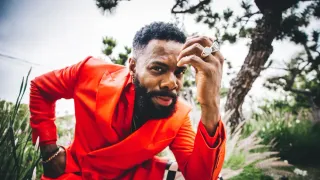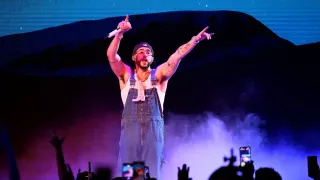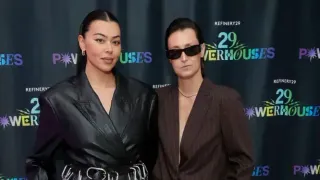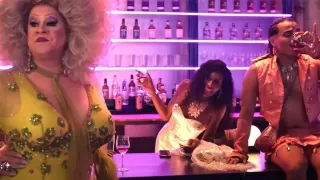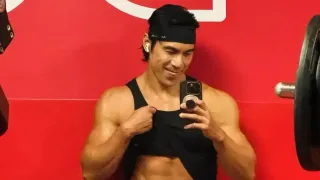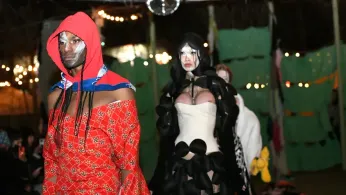
3 hours ago
Trans Designer Gogo Graham Champions Radical Visibility Through Fashion Made For and By Trans Women
READ TIME: 5 MIN.
In an industry that has long drawn inspiration from LGBTQ+ communities while simultaneously marginalizing their voices and profiting from their creativity without equitable representation, one designer is fundamentally restructuring the relationship between fashion and transgender visibility. Gogo Graham, a Texas-born, Brooklyn-based fashion designer, has emerged as a transformative force by creating a brand that centers trans women at every level of production, design, and presentation .
Graham's work fills a void that the mainstream fashion industry has historically ignored: clothing designed specifically for transgender women's bodies. While the fashion world has increasingly featured trans models on runways and in campaigns, the actual construction of garments has rarely accounted for the specific needs and proportions of trans women's bodies. Graham's approach represents a departure from this superficial inclusion, offering garments that are thoughtfully constructed with trans women as the primary consideration rather than an afterthought .
The designer gained significant attention as one of the first fashion brands to feature exclusively trans models in her shows and campaigns, establishing a new standard for authentic representation in an industry where visibility has too often been tokenistic. Her work challenges the notion that inclusion means simply placing diverse bodies in clothes designed for other people, instead insisting that true equity requires designing for those bodies from the ground up .
What distinguishes Graham's brand from other designers claiming inclusive values is her commitment to trans women throughout the entire production process. Her collections are not only designed for trans women but are also produced entirely by trans women, creating employment opportunities and economic empowerment within a community that faces disproportionate barriers to employment. This approach transforms fashion from a site of extraction—where LGBTQ+ aesthetics are commodified by those outside the community—into a space of genuine economic justice .
The model Graham has established speaks to broader conversations within LGBTQ+ fashion about who benefits from queer creativity. As CR Fashion Book noted in their June 2025 feature on LGBTQ+ designers, communities within the fashion industry have historically been "used for inspiration, celebrated as muses, and yet too often silenced while others profited off their influence" . Graham's business structure directly challenges this extractive pattern by ensuring that the community inspiring and wearing the clothes also creates and profits from them.
Graham's influence has extended beyond her own collections through collaborations with notable industry figures and cultural institutions. She has worked with the Women's History Museum, positioning trans women's experiences as integral to women's history—a politically significant gesture given ongoing debates about trans women's inclusion in feminist spaces and institutions. Additionally, her collaboration with RuPaul, one of the most visible figures in LGBTQ+ entertainment, has brought her work to wider audiences while maintaining her commitment to centering trans women's experiences .
These partnerships demonstrate how Graham has navigated the tension between maintaining community-centered values and achieving the visibility necessary to sustain a fashion business in a competitive market. By collaborating with established figures while refusing to compromise on her core mission, she has created a model for how emerging designers can scale their impact without diluting their political commitments.
Graham's work exists within a growing ecosystem of LGBTQ+ designers who are reshaping the fashion industry through their commitments to community, craftsmanship, and challenging gender norms. Designers like Mike Eckhaus and Zoe Latta of Eckhaus Latta have championed gender-neutral aesthetics and inclusive casting since launching their label in 2011, featuring models of every gender, age, shape, and size in their New York and Los Angeles-based brand .
Similarly, Conner Ives created the "Protect The Dolls" tee, which raised over $70,000 for Trans Lifeline, demonstrating how fashion can function as both aesthetic expression and direct material support for vulnerable communities . These designers collectively represent what CR Fashion Book described as "a story of resilience, craftsmanship, and inclusivity" that is redefining the relationship between fashion and LGBTQ+ communities .
Other designers in this movement include Dori Hazan of Sebastian Milano, who has emphasized celebrating femininity "free from the boundaries of gender" and designed clothing "to be worn by all," conveying "a message of acceptance of differences and gender irrelevance" . Hillary Taymour of Collina Strada combines eco-activism with playful, vibrant designs that champion self-expression and authenticity .
The significance of Graham's work extends beyond aesthetics into the realm of political visibility and material conditions for trans women. In a cultural moment marked by escalating legislative attacks on transgender rights, particularly targeting trans youth and trans women's access to public spaces, Graham's insistence on centering trans women in fashion represents a form of radical visibility. Her runway shows and campaigns make an unapologetic statement: trans women exist, trans women deserve clothing designed for their bodies, and trans women's labor and creativity deserve economic recognition and reward.
Spanish designer Alejandro Gómez Palomo of Palomo Spain has similarly used fashion to convey queer narratives, with his Spring/Summer 2025 collection "All of Heaven's Parties" questioning why emotions like lust and desire are deemed sinful and imagining them in divine paradise, even staging the show in a cathedral . This demonstrates how LGBTQ+ designers are using fashion as a medium for cultural commentary and challenging societal norms around gender, sexuality, and morality.
Graham's model also speaks to questions of economic sustainability for LGBTQ+ people, particularly trans women who face employment discrimination at disproportionate rates. By creating a business structure that employs trans women in skilled positions throughout the production process, Graham offers an alternative to the precarious economic conditions many trans people navigate. This approach treats fashion not merely as self-expression but as a site of economic empowerment and community building.
The growing visibility of brands like Gogo Graham, featured in publications like CR Fashion Book's June 2025 roundup of LGBTQ+ designers, suggests a potential shift in how the fashion industry approaches diversity and inclusion. Rather than settling for surface-level representation—placing diverse models in clothes designed without their bodies in mind—these designers insist that genuine inclusion requires structural changes in who designs, produces, and profits from fashion .
As the fashion industry continues to grapple with questions of representation, sustainability, and equity, designers like Gogo Graham offer concrete models for how businesses can center marginalized communities without exploitation. Her success demonstrates that there is both a market demand and a cultural appetite for fashion that takes inclusion seriously at every level of production.
Graham's work challenges other designers and brands to consider whether their commitments to LGBTQ+ communities extend beyond Pride Month marketing campaigns and token representation. By building a business that materially benefits trans women while creating clothing specifically designed for their bodies, she has established a standard against which other claims of inclusive fashion can be measured.
The emergence of designers like Graham, alongside the broader movement of LGBTQ+ fashion entrepreneurs highlighted in recent coverage, suggests that the relationship between fashion and queer communities may be shifting from one of extraction and inspiration to one of mutual benefit and genuine collaboration. Whether this shift will fundamentally transform the industry's power structures remains to be seen, but Graham's work offers a compelling vision of what truly inclusive fashion could look like: designed by, produced by, and centered on the communities it serves.
